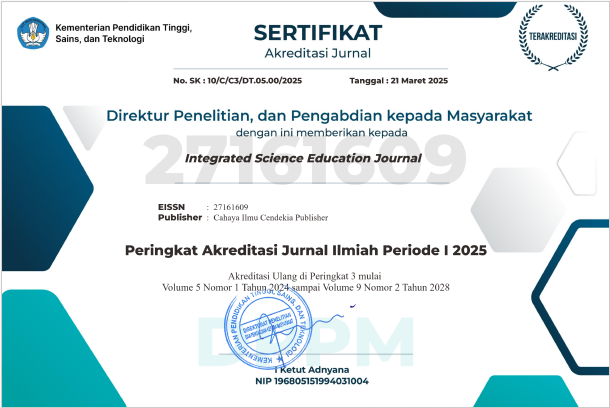A Study Comparison the Application of Discovery Learning and Problem Based Learning Models on the Critical Thinking Ability
Abstract
Purpose of the study: The purpose of this study is how are the differences in students' critical thinking skills in physics subjects using discovery and problem-based learning models at Madrasah Aliyah Laboratory in Jambi City.
Methodology: The research design used by researchers is a quantitative research type of quasi-experimental design using a pretest-posttest control group design, with a total sample of 56 students using a total sampling technique. The instrument in this study used a test with a Cronbach alpha of 0.919. The data analysis used includes descriptive and inferential statistics.
Main Findings: Based on the data analysis and discussion above, it can be concluded that students' critical thinking skills in physics subjects in static electricity material are in a good category. This indicates that the application of discovery learning models and problem-based learning can improve the thinking skills of critical students. This is reinforced by testing the hypothesis through an independent sample t-test that there is a significant difference between the use of the two models in improving students' critical thinking skills, especially in physics lessons on static electricity.
Novelty/Originality of this study: This research has a novelty, especially in cognitive, namely critical thinking skills, which can be improved with a scientific approach, especially using discovery learning models and problem-based learning.
References
D. C. Giancoli, Physics Fifth Edition Volume I. Jakarta: Erlangga.
A. Amilasari., and A. Sutiadi, “Increasing the academic proficiency of high school students in learning physics through the application of the guided inquiry learning model,” Jurnal Pengajaran MIPA FPMIPA UPI, vol. 12, no. 2, 2008.
N. Azizah., S. D. Fatmaryanti., and N. Ngazizah, “Application of the problem based learning (pbl) constructivism learning model to improve critical thinking skills in class xii students of sma negeri 1 kutowinangun class xii in the 2013/2014 academic year,” Radiation, vol. 5, no. 2, pp. 24–28, 2014.
C. Walsh., M. M. Stein., R. Tapping., E. M. Smith., and N. G. Holmes, “Exploring the effects of omitted variable bias in physics education research,” Physical Review Physics Education Research, vol. 17, no. 1, 2021.
D. Darmaji., D. A. Kurniawan., and I. Irdianti, “Physics education students' science process skills,” International Journal of Evaluation and Research in Education, vol. 8, no. 2, pp. 293-298, 2019.
S. Kanim., and X. C. Cid, “Demographics of physics education research,” Physical Review Physics Education Research, vol. 16, no. 2, 2020.
A. Purwanto., and R. Sasmita, “Learning physics by applying the guided inquiry model in growing the ability to think logically of students at sma negeri 8 bengkulu,” Proceedings of Semirata FMIPA, University of Lampung, pp. 249–253, 2013.
Y. Sudarmini., K. Kosim, and A. S. Hadiwijaya, “Physics learning based on guided inquiry using worksheets to improve critical thinking from the scientific attitudes of madrasah aliyah qamarul huda bagu bagu students, central Lombok,” Journal of Science Education Research (JPPIPA), vol. 1, no. 1, pp. 35–48, 2015.
S. A. Seibert, “Problem-based learning: A strategy to foster generation Z's critical thinking and perseverance. Teaching and Learning in Nursing, vol. 16, no. 1, pp. 85-88, 2021.
J. Maknun, “Implementation of guided inquiry learning model to improve understanding physics concepts and critical thinking skill of vocational high school students,” International Education Studies, vol. 13, no. 6, pp. 117-130, 2020.
G. Gunawan., A. Harjono., L. Herayanti., and S. Husein, “Problem-based learning approach with supported interactive multimedia in physics course: Its effects on critical thinking disposition,” Journal for the Education of Gifted Young Scientists, vol. 7, no. 4, pp. 1075-1089, 2019.
R. Diani., I. Irwandani., A. H. Al-Hijrah., Y. Yetri., D. Fujiani., N. S. Hartati., and R. Umam, “Physics learning through active learning based interactive conceptual instructions (ALBICI) to improve critical thinking ability,” Jurnal Penelitian Dan Pembelajaran IPA, vol. 5, no. 1, pp. 48-58, 2019.
P. Onsee., and P, Nuangchalerm, “Developing critical thinking of grade 10 students through inquiry-based STEM learning,” Jurnal Penelitian dan Pembelajaran IPA, vol. 5, no. 2, pp. 132-141, 2019.
H. Hidayat., M. Erna., and L. Anwar, “The problem-based learning model in improving concept understanding and self-confidence identification on chemical bonds at sma negeri 13 Pekanbaru,” Journal of Educational Sciences, vol. 5, no. 3, pp. 409-416, 2021.
E. K. Dewi, “The effect of using problem-based learning learning models on students' critical thinking ability in class xii civic education subjects at sman 22 Surabaya,” Moral and Citizenship Studies, vol. 2, no. 3, pp. 936–950, 2015.
F. Alatas, “The relationship between understanding concepts and critical thinking through the treffinger learning model in basic physics courses,” Edusains, vol. 6, no. 1, pp. 88–96, 2014.
M. B. Simanjuntak., M. Suseno., S. Setiadi., N. Lustyantie., and I. R. G. R. G. Barus, “Integration of curricula (curriculum 2013 and cambridge curriculum for junior high school level in three subjects) in pandemic situation,” Ideas: Jurnal Pendidikan, Sosial, dan Budaya, vol. 8, no. 1, pp. 77-86, 2022.
A. Agustriana., E. Ningrum., and L. Somantri, “The effect of using the discovery learning learning model on students' critical thinking ability (quasi-experimental research in class XIII IPS SMA,” Journal of Anthology of Geographic Education, no. 3, pp. 1–16, 2021.
R. E. Simamora., and S. Saragih, “Improving students' mathematical problem-solving ability and self-efficacy through guided discovery learning in local culture context,” International Electronic Journal of Mathematics Education, vol. 14, no. 1, pp. 61-72, 2019.
A. B. Susilo., W. Wiyanto., and S. Supartono, “Problem-based science learning model to increase learning motivation and critical thinking of middle school students,” Unnes Science Education Journal, vol. 1, no. 1, 2012.
F. Fakhriyah, “Application of problem-based learning in an effort to develop students' critical thinking ability,” Indonesian Journal of Science Education, vol. 3, no. 1, pp. 95–101, 2014.
U. Setyorini., S. E. Sukiswo., and B. Subali, “Application of problem-based learning models to improve critical thinking skills of middle school students,” Journal of Indonesian Physics Education, vol. 7, pp. 52–56, 2011.
J. W. Creswell, A Concise Introduction To Mixed Methods Research. SAGE publications, 2014.
K. Karim., and N. Normaya, “Kemampuan berpikir kritis siswa dalam pembelajaran matematika dengan menggunakan model jucama di sekolah menengah pertama,” EDU-MAT Jurnal Pendidikan Matematika, vol. 3, no. 1, pp. 92–104, 2015.
S. Srianty., A. Samad, “Upaya meningkatkan kemampuan bepikir kritis fisika siswa kelas xiii ipa 3 sma negeri 1 bungoro melalui model pembelajaran generatif,” JSPF, vol. 7, no. 1, pp. 1–12, 2011.
D. Cramer, Advanced Quantitative Data Analysis. McGraw-Hill Education (UK), 2003.
F. A. Astari., S. Suroso., and Y. Yustinus, “Efektifitas penggunaan model discovery learning dan model problem-based learning terhadap hasil belajar ipa siswa kelas 3 sd,” Jurnal Basicedu, vol. 2, no. 1, pp. 1-10, 2018.
N. Kiftiah, “Perbedaan kemampuan komunikasi matematis siswa dalam model pembelajaran problem based learning dan model pembelajaran langsung pada materi bangun ruang sisi datar,” Jor. Eva. Edu, vol. 3, no. 1, pp. 13-18, 2022.
E. A. M. Castro, “Analysis of Problem Solving Ability of First Middle School Students in Learning Science,” In. Sci. Ed. J, vol. 4, no. 2, pp. 43-53, 2023.
V. Karlina and R. Asma, “The effectiveness of using guided discovery learning models on student learning outcomes on reaction rate materials in class XI,” In. Sci. Ed. J, vol. 3, no. 3, pp. 72-77, 2022.
S. F. Jufri and A. Srimadona, “Analysis of the implementation of the discovery learning model and its effect on creative attitudes in solubility learning in class XI MIA SMAN 2 Jambi City,” In. Sci. Ed. J, vol. 3, no. 3, pp. 78-85, 2022.
H. Hosnan, Scientific and Contextual Approaches in 21st Century Learning. Bogor: Ghalia Indonesia, 2014.
Y. Affandi., A. Darmuki., and A. Hariyadi, “The evaluation of jidi (jigsaw discovery) learning model in the course of qur'an tafsir,” International Journal of Instruction, vol. 15, no. 1, pp. 799-820, 2022.
W. Saryadi., and D Sulisworo, “Development of e-module based on the discovery learning to improve the student creative thinking skills,” JTAM (Jurnal Teori Dan Aplikasi Matematika), vol. 7, no. 1, pp. 11-22, 2023.
S. B. A. Neswary., and B. K. Prahani, “Profile of students' physics critical thinking skills and application of problem based learning models assisted by digital books in physics learning in high school,” Jurnal Penelitian Pendidikan IPA, vol. 8, no. 2, pp. 781-789, 2022.
S. Samadun., and D. Dwikoranto, “Improvement of student's critical thinking ability sin physics materials through the application of problem-based learning,” IJORER: International Journal of Recent Educational Research, vol. 3, no. 5, pp. 534-545, 2022.
Copyright (c) 2023 Muhammad Akhir, Jodion Siburian, Muhammad Haris Effendi Hasibuan

This work is licensed under a Creative Commons Attribution-NonCommercial 4.0 International License.
Authors who publish with this journal agree to the following terms:
- Authors retain copyright and acknowledge that the Integrated Science Education Journal is the first publisher licensed under a Creative Commons Attribution 4.0 International License.
- Authors are able to enter into separate, additional contractual arrangements for the non-exclusive distribution of the journal's published version of the work (e.g., post it to an institutional repository or publish it in a book), with an acknowledgment of its initial publication in this journal.
- Authors are permitted and encouraged to post their work online (e.g., in institutional repositories or on their website) prior to and during the submission process, as it can lead to productive exchanges and earlier and greater citation of published work.







.png)
.png)






